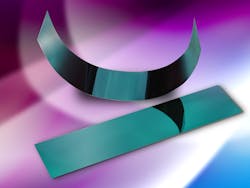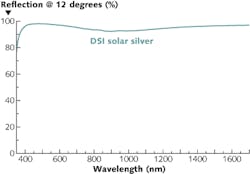BOB CRASE
The technology to produce optical coatings has been improving at an astonishing rate. Coatings that recently were considered "high-performance" are now thought of as standard production. With all the changes in the optical coating industry, it is imperative that we understand the availability and importance of these high-performance coatings.
What defines a high-performance optical coating in today's world? The answer can depend on system requirements, environmental considerations, the coating of unique substrates, and coatings that are integral features of specific products. Any one of these conditions presents its own special set of opportunities and challenges in today's coating industry.
Spectral high performance
Spectral performance is the first area that comes to mind when considering high-performance coatings. Coating-control technology has quickly progressed, allowing the manufacture of coatings to much tighter coating specifications. For example, advances made in telecom dense wavelength-division-multiplexing filters redefined the narrow bandpass from 10 nm in width to subnanometer widths. Because these filters are of relatively small size (on the order of 1 mm square), coating uniformity has not been an issue. However, as a result of the telecom implosion, this technology has been refined and adapted to other coatings. Today, edge filters of 50 mm diameter can be produced with a uniformity of +/- 0.2% and a placement accuracy of +/- 0.2%.
Unusual substrates
The nature of the substrate will determine the type of high performance coating that should be applied. Metal-based mirrors and plastic optics are consistently used as either cost-reduction or performance-enhancement vehicles. Metal sheets of stainless steel or aluminum can replace glass as collection mirrors for nonimaging systems such as UV printing, UV curing, and x-ray imaging systems (see Fig. 1). However, these systems still need the performance of a dielectric coating. The advantage of metal mirrors is they can be coated in sheet form and fabricated after coating into complex shapes and curved parts. This allows them to be produced at a lower cost than glass.
The use of plastic as an optical material is becoming more commonplace. Plastics have unique attributes that require the coatings deposited on them to be of high performance. Using plastics allows a great deal of flexibility for the optics designer, as well as the potential for cost reductions in the system. Plastic optics can be molded with mounting features as part of the optic, reducing the need for intricate mounting schemes in the optical system. Small parts can be molded in a cluster of multiple parts that allows them to be coated as a single unit. This reduces handling during the coating process which leads to additional cost savings in the coating operation.
Unlike glass or metal, plastics have a relatively low-temperature melting point. Coatings deposited at low temperatures using electron-beam technology end up relatively soft, thereby reducing the durability of the applied coating. As an alternative, sputtering systems—such as the proprietary MicroDyn reactive sputtering deposition process developed by Deposition Sciences (DSI)—can deposit hard coatings at low temperatures, thereby greatly increasing the filter's durability.
The surface characteristics of some plastics can make it difficult for coating materials to adhere to them. Experimentation is often required to find the correct combination of coatings materials that will maximize adhesion to the plastic.
In use, optical coatings are inherently under stress. This can present a problem when coating plastics, since plastics are not as rigid as glass or metal and therefore can cause the coatings to become unstable. With relatively thin coatings such as antireflection and metal-film coatings, stress is generally not an issue. However when coatings approach 2 µm in thickness, the intrinsic stress in the films can become a problem. The film stress can cause the optic to deform and, if the coating is thick enough, cause the film itself to fracture and craze. Process parameters must be adjusted to minimize film stress.
Environmental ruggedness
The increased use of optical coatings in harsh environments demands durable and dependable performance. In the past, optics used on satellites, military ships, and weapons systems were the most challenging applications. The ever-changing role of the military has caused these performance requirements to progress rapidly. External optics used on aircraft are required to withstand blowing sand and dust for extended periods of time. In the past, hard carbon coatings were the answer for the IR region of the spectrum where most of these types of optics operated. With the advent of unmanned aerial vehicles, payloads now operate in the near-IR and visible regions of the spectrum. Because of its poor transmission in these spectral regions, hard carbon is no longer an option. Several proprietary formulations are now being tested to both withstand this rugged environment and to be transparent in the visible and near IR.
While military applications push the envelope of environmental requirements, the world of nonmilitary optics is now also demanding higher performance. Renewable energy is an area that requires both high spectral performance and environmental durability. Concentrating-photovoltaic (CPV) systems use mirrors to collect and focus light onto multijunction solar cells that are capable of converting sunlight in the very broad 350 to 1700 nm wavelength range. The best reflective material for this application is silver; however, silver is not an environmentally robust material. In CPV applications, the mirror must remain outdoors and have a service life of 25 years. Since CPV is a relatively young field, there are no systems with silver mirrors that have been in service for this amount of time. With that being said, durable silver coatings are available that routinely pass minimum 28-day humidity tests, 200°C thermal cycling, and adhesion tests (see Fig. 2).High performance as an integral product feature
In some applications, such as energy-efficient lighting, the coating becomes an integral part of the performance of the product. To improve the collection efficiency in a metal halide lighting application, a cold mirror is coated directly onto the lamp envelope. The cold mirror has nominally 90% reflectivity across the visible spectrum, which is not high performance; however the temperature of the envelope is in excess of 1000°C. The coating must not only survive these extreme temperatures, but must also maintain its performance over the 6000-hour life of the lamp.
The next generation of LEDs will need improved collection efficiency. The reflectors will be integrated into the plastic mount of the reflector. This coating will need to be highly reflective over a wide range of incident angles, over a wide area of the visible spectrum, and maintain this performance over tens of thousands of hours.Hybrid incandescent lighting is another area where the coating is an integral product feature. This particular energy-efficient-lighting application requires a high-performance, hot-mirror coating that is coated directly onto the lamp envelope. The lamp envelope is designed to focus the reflected IR energy onto the tungsten filament. It is essential that the hot mirror be highly transmissive and color-neutral in the visible spectrum and highly reflective over a wide range of IR wavelengths. The performance of the coating determines the energy efficiency of the lamp (see Fig. 3).
Bob Crase is assistant director of commercial manufacturing at Deposition Sciences, 3300 Coffey Lane, Santa Rosa, CA 95403; www.depsci.com; e-mail: [email protected].


